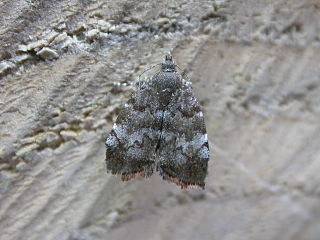
Choreutidae, or metalmark moths, are a family of insects in the lepidopteran order whose relationships have been long disputed. It was placed previously in the superfamily Yponomeutoidea in family Glyphipterigidae and in superfamily Sesioidea. It is now considered to represent its own superfamily. The relationship of the family to the other lineages in the group "Apoditrysia" need a new assessment, especially with new molecular data.

Anthophila fabriciana, also known as the common nettle-tap, is a moth of the family Choreutidae first described in 1767 by Carl Linnaeus. The moth can be found flying around stinging nettles during the day.
Pyrrhia treitschkei is a moth of the family Noctuidae. It is found in Turkey, the Caucasus, the Balkans, Iran and the Levant (only recorded from Lebanon and Israel.

Prochoreutis myllerana, Miller’s nettle-tap or small metal-mark, is a moth of the family Choreutidae found in Asia and Europe. Miller's nettle-tap was first described by Johan Christian Fabricius in 1794 from a specimen found in Sweden.
Choreutis sycopola is a species of moth of the family Choreutidae. It is found from southern Queensland to central New South Wales.

Choreutis nemorana, the fig-tree skeletonizer moth or fig leaf roller, is a species of moth of the family Choreutidae.
Caloptilia scutellariella is a moth of the family Gracillariidae. It has been recommended that this species be further studied as its placement within the genus Caloptilia is in need of clarification. It is known from Ontario, Canada, and Ohio and Michigan in the United States.

Prochoreutis sestediana, also knowns as the silver-dot metal-mark is a moth of the family Choreutidae found in Asia and Europe. It was first described by Johan Christian Fabricius in 1776 from a specimen found in Kiel, Germany.
Tortyra fulgens is a moth of the family Choreutidae. It was described by Cajetan Felder, Rudolf Felder and Alois Friedrich Rogenhofer in 1875 and is known from Colombia, Brazil and Bolivia.

Tebenna silphiella, the rosinweed moth, is a moth of the family Choreutidae. It is known from the central part of the United States, including Wisconsin, Illinois and Colorado. The habitat consists of prairies and meadows.
Tebenna carduiella is a moth of the family Choreutidae. It is found in the United States from New Jersey to Florida and west to Texas.
Tebenna submicalis is a moth of the family Choreutidae. It is known from China, Nepal, Russia and Japan (Hokkaido).
Prochoreutis holotoxa is a moth of the family Choreutidae. It is known from China (Shanxi), France (Alps), Italy, Austria (Tirol), Switzerland (Zermatt), Romania and Russia (Siberia).
Anthophila alpinella is a moth of the family Choreutidae. It is found from the north-eastern United States and southern Canada to British Columbia, the Rocky Mountains, and along the Pacific Coast to Marin County, California.

Choreutis pariana, the apple-and-thorn skeletonizer or apple leaf skeletonizer, is a moth of the family Choreutidae. The moth was first described by the Swedish entomologist Carl Alexander Clerck in 1759. It is native to Eurasia and was introduced to New England, USA in 1917. It was recenly also stated in Korea.

Millieria is a genus of moths in the family Choreutidae, containing only one species, Millieria dolosana, which is found from Morocco north to Germany, France and Poland, east to southern Russia and Israel.
Amblyptilia direptalis is a moth of the family Pterophoridae. It is known from Ethiopia, Kenya, South Africa, Tanzania, India and Sri Lanka.
Choreutis aegyptiaca is a species of moth of the family Choreutidae. It is found in the India, Nepal, Israel, Saudi Arabia, the United Arab Emirates, Yemen, Egypt, La Réunion, Nepal, Oman, Uganda, Namibia and South Africa.
Brenthia coronigera, commonly known as the metalmark moth, is a species of moth of the family Choreutidae. It was described by Edward Meyrick in 1918. It is found in the Bengal region of what was British India.

Helcystogramma convolvuli, the sweet potato moth, sweetpotato webworm moth, sweetpotato leaf roller or black leaf folder, is a moth of the family Gelechiidae. It is mainly found in Asia and Africa, but there are also records from Oceania, the Middle East, the Caribbean and Florida in the United States. The species is also found on the Canary Islands and Madeira.










